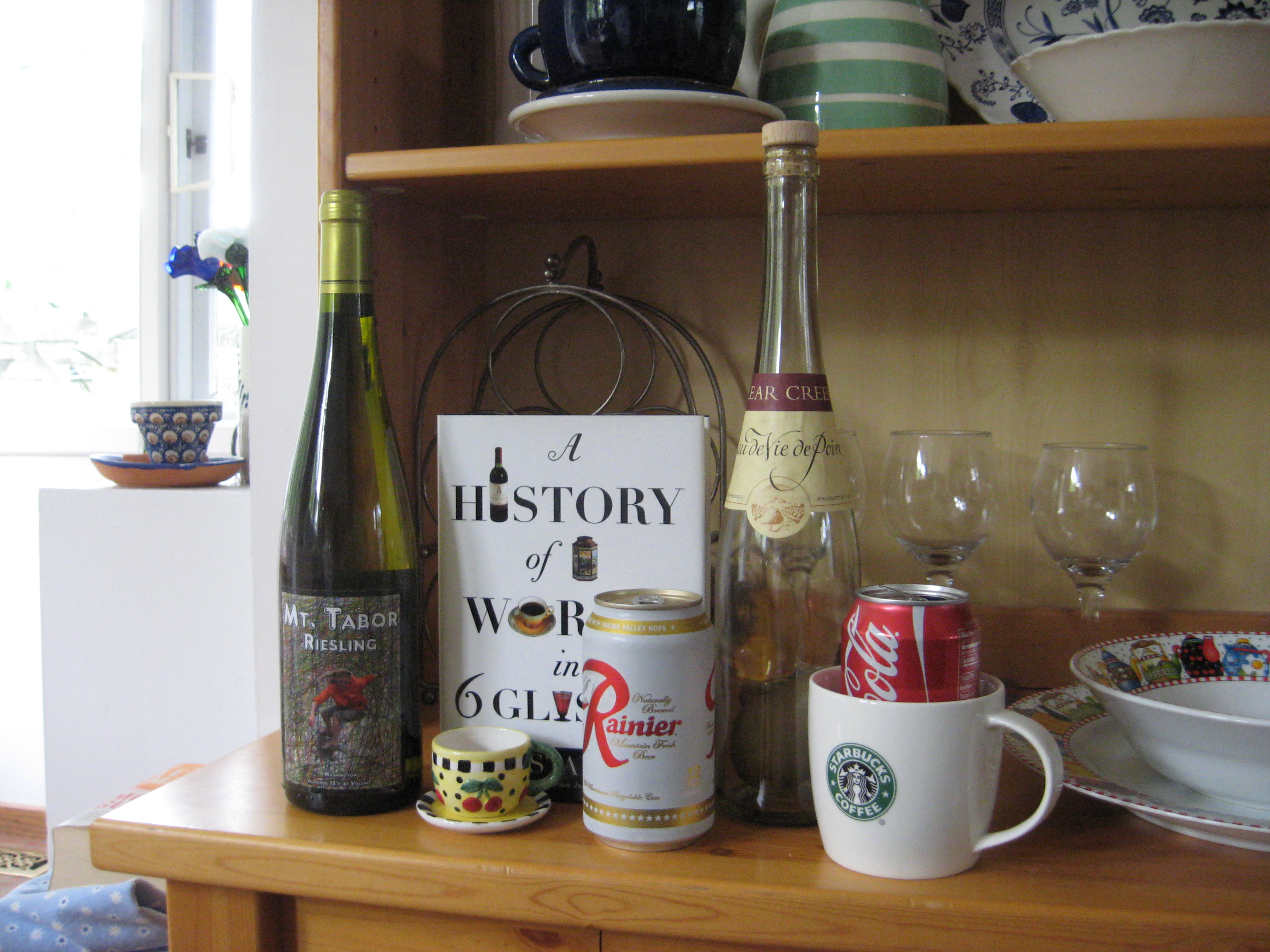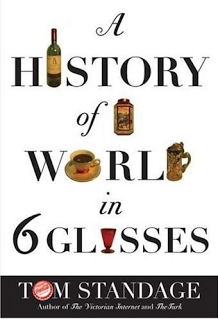 A History of the World in Six Glasses by Tom Standage A History of the World in Six Glasses by Tom Standage
I first read A History of the World in Six Glasses by Tom Standage for fun (yes, fun). I love an old-fashioned dog-earred book with scribbling in the margins, but this 240-page book is available in multiple formats -- major bookstore, online booksellers, for the Kindle, IPad, and the Nook. I have also provided links below to free .pdf files and an audio book, though both formats are cumbersome.
 This assignment will give you an overview of the time periods, regions, and cultural customs we cover in Honors and Advanced Placement World history. This assignment will give you an overview of the time periods, regions, and cultural customs we cover in Honors and Advanced Placement World history.
Disclaimer: The use of this book as a summer reading assignment in no way represents any endorsement by Naples High School of the use or misuse of any of these beverages, alcoholic, caffeinated, or otherwise. The book merely offers an innovative and interesting perspective to initiate our year-long discussion of world history.
|
Video Files
Great credit goes to David Duez, AP World History teacher in Kingwood, Texas, for creating entertaining screencasts for each drink (Notes, too). Very impressive.
.PDF Files
.Pdf files have been removed at the request of the publisher. Obviously, other sites may still have them online. |
|

Audiophile
Entire book available. |
Illustrated Journal: There are five key themes that emerge for each drink. Identify how each of these themes emerged for these six beverages. Present these five themes for each libation. Be as creative as you wish. (.pdf of assignment)
Five Themes:
1. Food and Nutrition
2. Medicine
3. Currency
4. Social Class and Status, and
5. How This Drink Led to Change.
Here is an example of how these themes might be specified for the first drink -- beer:
· Why was beer considered nutritious?
· How was it used as medicine?
· How did beer determine social class status?
· How was it used as money?
· How did beer change society?
Divide the journal into six sections – one for each drink -- and write/draw/collage/cartoon what you learned based on the five themes for each of these six beverages. This self-contained booklet with illustrations, quotes, your commentary and questions should be attractive, informative, reflective.
Below are some suggested topics you might want to write about for each glass.
- How does the story of each glass open up your understanding of world history and trade?
- How did it benefit and or hurt both producer and consumer?
- What did you learn about geography and resources as you studied these different beverages in the different regions?
- What did you learn about class and social structure as well as religion in studying beverages (and/or food)?
- How do these new drinks become accepted in part through their supposed medicinal value?
Timeline: Create a timeline of history including each “glass/beverage.” Your timeline should include at least two regions of the world affected by your “glass/beverage” and five dates with facts for each “glass/beverage” for a total of at least thirty dates and facts on the timeline. It should be illustrated appropriately and dense with detail. (You may use Inspiration or Prezi.) (.pdf of assignment)
Study Questions OR Summaries: Chapter Questions. |
|
Map Activity: You are going to create two dense/detailed maps, so be neat and tidy. Create a legend if you need to use symbols (highly recommended) for cities on the map. Use two maps —World Map for Chapters 5 and 6; Eurasia for all other chapters. (.pdf of assignment) Maps
Chapters 1-4: Eurasia
- Use yellow to shade the entire area that was touched by the use of beer & wine according to these chapters
- Label any geographical reference for these chapters in RED INK. Cities, regions (Fertile Crescent), rivers, mountains, deserts, plateaus, seas, oceans. If it is a region you are identifying, use red diagonal lines to denote the region.
Chapters 5-6: World
- Use a pale green to shade the entire area touched by distilled spirits according to these chapters.
- Label any geographical reference for these chapters in GREEN INK. Cities, regions, rivers, mountains, deserts, plateaus, seas, oceans. If it is a region you are identifying, use red diagonal lines to denote the region.
- Notate overlapping cities, cities that were important during the previous period, on the back of your map.
Chapters 7-8: Eurasia
- Use a pale blue to shade the entire area touched by coffee according to these areas.
- Label any geographical reference for these chapters in BLUE INK. Cities, regions, rivers, mountains, deserts, plateaus, seas, oceans. If it is a region you are identifying, use red diagonal lines to denote the region.
- Notate overlapping cities, cities that were important during the previous period, on the back of your map.
Chapters 9-10: Eurasia
- Use a light brown to shade the entire area touched by tea according to these areas.
- Label any geographical reference for these chapters in BLACK INK. Cities, regions, rivers, mountains, deserts, plateaus, seas, oceans. If it is a region you are identifying, use red diagonal lines to denote the region.
- Notate overlapping cities, cities that were important during the previous period, on the back of your map.
|
For the Teacher
This is one of my absolute favorite books to teach in world history. Introducing students to projects which can be referenced all year, I use it as a touchstone, or foundational, text. Please feel free to contact me if you choose to teach this book. I have additional files I can share with patrons and donors of my website.
- LitCharts (always wonderful) has an exceptional set of materials for this book. While much of the material is available online, the cost for a one-month subscription is only $10.00 and is well worth the it. The Teacher edition has answers for all study charts.
- AP Style Review Packets for Each Chapter (from Teachers Pay Teachers $14.00) Each packet contains a regional timeline (taken from the Princeton Review book), big picture questions, an essential question (or “So What”) thesis statement exercise, an AP World notes theme activity, and an important term definition and linking activity. Beautiful graphics. WOW!
- Mulford’s Chapter Notes & Study Guides (available in .pdf and .doc formats)
- Review: “Drinking in the Past” from American Scholar can serve as an introduction to the text. Also useful if parents question the assignment.
- 35 Study Questions (by chapter with quotes)
- Rubric for Grading Questions and Projects
- AP Style ExamView Question Banks (From College Board AP List Serv) [Must be emailed to school/teacher email]
|


